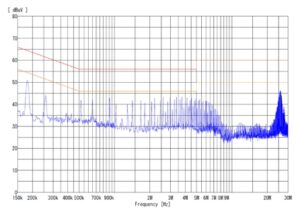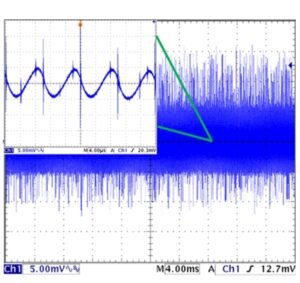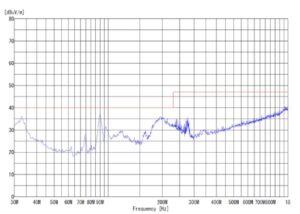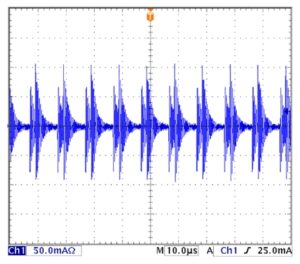Switching power supplies (SMPS) are widely used in electronic equipment due to their compact size, high efficiency, and lightweight design. However, these advantages come with a significant challenge: noise generation. Noise from switching power supplies can interfere with the proper functioning of the equipment and cause electromagnetic interference (EMI), impacting not only the device itself but also surrounding devices.
In this blog, we’ll explore the sources of power supply noise, its types, and effective strategies for how to eliminate noise from switching power supply systems.
Sources of Power Supply Noise
Noise in switching power supplies primarily originates from the high-speed switching of transistors and other semiconductor components. When the power supply switches between on and off states at high frequencies, the transition causes unwanted electromagnetic waves. These waves can either radiate through the air or propagate through the circuit, leading to interference. Power supply noise can be classified into several types, each with unique characteristics and mitigation strategies.
3 Types of Power Supply Noise
To effectively eliminate noise from switching power supplies, it’s essential to understand the different types of noise that can be generated:
| Noise Type | How to Reduce |
|---|---|
| Conducted Emission | Install input filters, use EMC filters |
| Ripple Noise | Use filtering capacitors, choose high-quality capacitors |
| Radiated Emission | Implement shielding, arrange cables to minimize radiation |
Conducted Emission

Conducted emission noise refers to unwanted electrical noise that travels along power supply lines or signal lines, typically back to the AC supply. It can also affect other circuits within the same system or externally. This type of noise includes harmonics of the switching frequency, making it more challenging to control.
How to reduce switching power supply noise from conducted emission?
-
Install input filters to prevent noise from entering the system.
-
Use specialized EMC (Electromagnetic Compatibility) filters that block or attenuate these emissions before they affect sensitive components.
Ripple Noise

Ripple noise occurs when the AC signal remains superimposed on the DC output of the power supply. This fluctuation results from the switching process and can degrade the performance of sensitive components. Typically, ripple noise is measured as a percentage of the output voltage.
How to reduce ripple noise?
-
Use additional filtering capacitors to smooth out the voltage waveform.
-
Opt for high-quality capacitors that provide better ripple rejection at the switching frequency.
Radiated Emission

Radiated emission noise refers to electromagnetic radiation emitted from the power supply’s components or wires. This type of noise can disrupt other nearby devices, especially those sensitive to radio frequency (RF) signals. Strict standards exist for radiated emission levels to minimize interference with communications and other electronic systems.
How to reduce radiated emission?
-
Implement shielding techniques to prevent radiated energy from escaping.
-
Ensure that cables and components are properly arranged to minimize radiation.
Common Mode Noise

Common mode noise occurs when unwanted noise currents flow between the power lines and ground. This type of noise can lead to voltage surges and is particularly problematic for audio, video, and data systems. Common mode noise often travels through the power line and can cause malfunctions in sensitive electronic devices.
How to reduce common mode noise?
-
Use common-mode chokes and filters to block noise before it enters the circuit.
-
Ensure proper grounding and layout to minimize noise coupling.
Impact of Noise on Switching Power Supply
The impact of power supply noise can be severe, both for the device itself and for other electronic systems. Some of the key consequences include:
-
Malfunctioning Circuits: Noise can interfere with sensitive circuits, causing them to behave unpredictably.
-
Signal Distortion: In systems such as audio and video equipment, noise can cause distortion in the signals, leading to degraded performance.
-
Reduced Efficiency: Excessive noise can cause energy losses, impacting the overall efficiency of the power supply.
-
Component Damage: High levels of EMI or noise may damage electronic components, leading to device failure.
How to Eliminate Noise from Switching Power Supply
To effectively eliminate or reduce switching power supply noise, various strategies and techniques can be applied. Below, we outline some of the most effective methods.
Improving Circuit Design
A well-designed circuit can significantly reduce the amount of noise generated. Consider the following design tips:
-
Use low-noise components where possible.
-
Optimize layout to minimize noise paths, especially between the power supply and sensitive components.
-
Ensure that the ground plane is well-designed to prevent ground loops, which can exacerbate noise issues.
Using Filters
Filters are an essential tool for noise reduction in switching power supplies. Several types of filters can be used, including:
-
LC Filters: These combine inductors and capacitors to filter out high-frequency noise.
-
RC Filters: These use resistors and capacitors to smooth out signals and reduce ripple noise.
-
Common Mode Filters: These filters block noise traveling through both the live and neutral lines simultaneously, effectively reducing common mode noise.
Electromagnetic Compatibility (EMC) Design
Electromagnetic compatibility (EMC) design is crucial for ensuring that a switching power supply can operate without causing or being affected by noise. Effective EMC design prevents unwanted electromagnetic interference from radiating or coupling into the circuit. Here are key strategies:
Importance of EMC
Incorporating EMC design into your power supply ensures compliance with regulatory standards and prevents interference with other devices. It also contributes to the overall stability and reliability of the system.
Four Basic EMC Strategies
Effective EMC design relies on four primary strategies to reduce or eliminate noise:
-
Reflection: This involves blocking the conduction of noise using LC filters. It helps prevent noise from propagating through the power lines.
-
Absorption: Ferrite cores and chip beads can absorb noise and convert it into heat, reducing its impact on the power supply.
-
Bypassing: Capacitors and varistors can divert noise to ground, helping to mitigate high-frequency disturbances.
-
Shielding: Enclosing the power supply in a metal case or using a radio wave absorber like ferrite can prevent radiated noise from escaping the power supply and interfering with other systems.
Conclusion
Switching power supply noise is an inevitable byproduct of high-efficiency designs, but it can be effectively managed with the right techniques. By understanding the sources and types of noise—conducted emission, ripple noise, radiated emission, and common mode noise—you can implement strategies like improving circuit design, using filters, and applying EMC measures to minimize interference.
If you’re looking to reduce switching power supply noise, it’s essential to focus on a holistic approach that incorporates these strategies. With the right tools and design practices, you can ensure that your switching power supply operates efficiently, quietly, and in compliance with industry standards.








